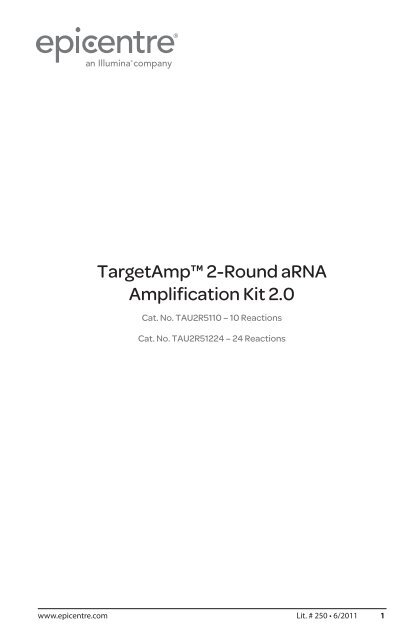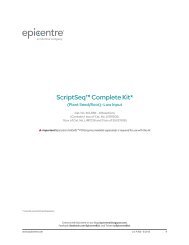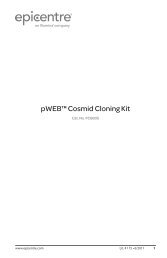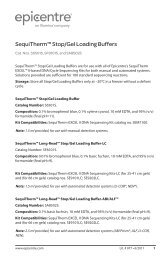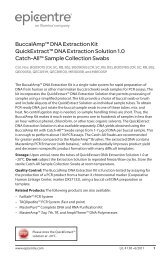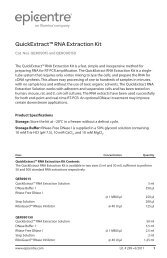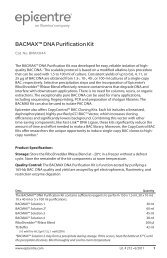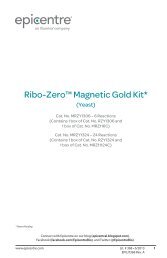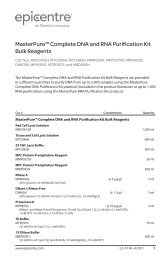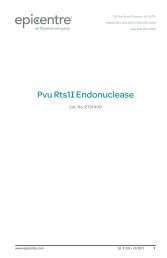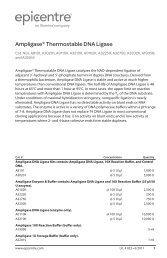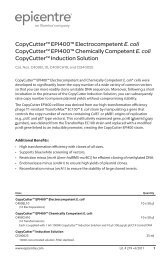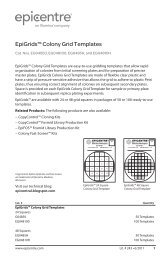Protocol for TargetAmp⢠2-Round aRNA Amplification Kit 2.0
Protocol for TargetAmp⢠2-Round aRNA Amplification Kit 2.0
Protocol for TargetAmp⢠2-Round aRNA Amplification Kit 2.0
Create successful ePaper yourself
Turn your PDF publications into a flip-book with our unique Google optimized e-Paper software.
TargetAmp 2-<strong>Round</strong> <strong>aRNA</strong><strong>Amplification</strong> <strong>Kit</strong> <strong>2.0</strong>Cat. No. TAU2R5110 – 10 ReactionsCat. No. TAU2R51224 – 24 Reactionswww.epicentre.com Lit. # 250 • 6/2011 1
TargetAmp 2-<strong>Round</strong> <strong>aRNA</strong> <strong>Amplification</strong> <strong>Kit</strong> <strong>2.0</strong>Table of Contents<strong>Kit</strong> Contents...................................................................................................................................................... 3Storage............................................................................................................................................................... 3Additionally Required Reagents and Equipment................................................................................ 3Per<strong>for</strong>mance Specifications and Quality Control................................................................................ 4Introduction.................................................................................................................................................... 4Features and Benefits of the TargetAmp 2-<strong>Round</strong> <strong>aRNA</strong><strong>Amplification</strong> <strong>Kit</strong> <strong>2.0</strong>................................................................................................................................... 4<strong>Round</strong>-One, 1 st -strand cDNA Synthesis.................................................................................................. 4<strong>Round</strong>-One, 2 nd -strand cDNA Synthesis................................................................................................. 4<strong>Round</strong>-One, In Vitro Transcription............................................................................................................. 4<strong>Round</strong>-One, RNA Purification..................................................................................................................... 4<strong>Round</strong>-Two, 1 st -strand cDNA Synthesis................................................................................................... 5<strong>Round</strong>-Two, 2 nd -strand cDNA Synthesis.................................................................................................. 5In Vitro Transcription of <strong>aRNA</strong>..................................................................................................................... 5Preparation...................................................................................................................................................... 6Assessing the Quality of the Total RNA............................................................................................... 6-7Maintaining an RNase-free Environment............................................................................................... 7Input Total RNA and <strong>aRNA</strong> Yield................................................................................................................ 8<strong>aRNA</strong> Purification............................................................................................................................................ 9Additional Suggestions................................................................................................................................ 9RNA <strong>Amplification</strong> Procedure...............................................................................................................10<strong>Round</strong>-One, 1 st -strand cDNA Synthesis......................................................................................... 10-11<strong>Round</strong>-One, 2 nd -strand cDNA Synthesis...............................................................................................11<strong>Round</strong>-One, In Vitro Transcription...........................................................................................................12<strong>Round</strong>-One, RNA Purification...................................................................................................................13<strong>Round</strong>-Two, 1 st -strand cDNA Synthesis.......................................................................................... 14-15<strong>Round</strong>-Two, 2 nd -strand cDNA Synthesis................................................................................................15In Vitro Transcription of <strong>aRNA</strong>...................................................................................................................16<strong>aRNA</strong> Purification................................................................................................................................... 17-18Quantifying the Concentration, Yield and Fold-<strong>Amplification</strong> of the <strong>aRNA</strong>............................18Assessing the Size of the <strong>aRNA</strong> Produced ...........................................................................................19Appendix 1The TargetAmp 2-<strong>Round</strong> <strong>aRNA</strong> <strong>Amplification</strong> <strong>Kit</strong> <strong>2.0</strong> Control Reaction....................................19Additional TargetAmp <strong>aRNA</strong> <strong>Amplification</strong> <strong>Kit</strong>s & Selection Guide........................... 20-21Related Products........................................................................................................................................22Reference........................................................................................................................................................232 www.epicentre.com
<strong>Kit</strong> ContentsTargetAmp 2-<strong>Round</strong> <strong>aRNA</strong> <strong>Amplification</strong> <strong>Kit</strong> <strong>2.0</strong>The kit components are supplied in tubes with colored caps <strong>for</strong> easier identification.The kit has been developed <strong>for</strong> use with and will provide optimal results withSuperScript III and SuperScript II Reverse Transcriptases (Invitrogen Corp.; provided bythe user).Reaction Size <strong>Kit</strong>sComponent Name Tube Label 10 24______________________________ Red-Cap Tubes ______________________________TargetAmp T7-Oligo(dT) Primer B T7-Oligo(dT) Primer B 15 μl 30 μlTargetAmp Reverse Transcription PreMix-SS RT PreMix-SS 50 μl 90 μlTargetAmp DNA Polymerase PreMix-SS 1 DNA Pol PreMix-SS 1 60 μl 120 μlTargetAmp DNA Polymerase-SS 1 DNA Polymerase-SS 1 10 μl 18 μlTargetAmp cDNA Finishing Solution-SS Finishing Solution-SS 15 μl 30 μl______________________________ Blue-Cap Tubes ______________________________TargetAmp Random Primers-SS Random Primers-SS 30 μl 55 μlTargetAmp RNase H-SS RNase H-SS 10 μl 18 μlTargetAmp T7-Oligo(dT) Primer C T7-Oligo(dT) Primer C 15 μl 30 μlTargetAmp DNA Polymerase PreMix-SS 2 DNA Pol PreMix-SS 2 150 μl 360 μlTargetAmp DNA Polymerase-SS 2 DNA Polymerase-SS 2 10 μl 18 μl______________________________ Green-Cap Tubes ______________________________TargetAmp In Vitro Transcription PreMix A IVT PreMix A 300 μl 725 μlTargetAmp T7 RNA Polymerase T7 RNA Polymerase 100 μl 225 μlTargetAmp T7 Transcription Buffer T7 Transcription Buffer 100 μl 225 μl100 mM ATP ATP 50 μl 110 μl100 mM CTP CTP 50 μl 110 μl100 mM GTP GTP 50 μl 110 μl100 mM UTP UTP 50 μl 110 μlRNase-Free DNase I DNase I 50 μl 115 μl______________________________ Colorless-Cap Tubes ______________________________Dithiothreitol (DTT) DTT 100 μl 250 μlHeLa Total RNA Control (40 ng/μl) HeLa Total RNA Control 10 μl 10 μlRNase-Free Water RNase-Free Water 2 x 1 ml 2 x 1 mlPoly(I) Poly(I) 30 μl 30 μlStorage: Upon receipt of this kit, remove the tube containing the HeLa Total RNA Controland store it at –70°C to –80°C. Store the remainder of the kit at –20°C.Additional Required Reagents and Equipment:SuperScript III and SuperScript II Reverse Transcriptase (Invitrogen Corp.)Thermocycler or water bathMicrocentrifugeRNase-Free WaterRNeasy® MinElute® Cleanup <strong>Kit</strong>orRNeasy Mini <strong>Kit</strong> (Qiagen) (see “<strong>aRNA</strong> Purification” page 17 <strong>for</strong> details)techhelp@epicentre.com • (800) 284-8474 3
TargetAmp 2-<strong>Round</strong> <strong>aRNA</strong> <strong>Amplification</strong> <strong>Kit</strong> <strong>2.0</strong>Per<strong>for</strong>mance Specifications and Quality ControlThe TargetAmp 2-<strong>Round</strong> <strong>aRNA</strong> <strong>Amplification</strong> <strong>Kit</strong> <strong>2.0</strong> is function-tested in a controlreaction. The kit must produce at least 20 μg of <strong>aRNA</strong> (cRNA) from 200 pg of HeLa TotalRNA Control, corresponding to a greater than 5,000,000-fold amplification of the Poly(A)RNA assuming that 2% of the HeLa Total RNA Control is Poly(A) RNA. A negative controlreaction (“no-RNA” control) produces less than 2 μg of <strong>aRNA</strong>.IntroductionFeatures and Benefits of the TargetAmp 2-<strong>Round</strong> <strong>aRNA</strong> <strong>Amplification</strong> <strong>Kit</strong> <strong>2.0</strong>:1) Greater than 5,000,000-fold amplification of the Poly(A) RNA contained in a total RNAsample.2) Produce microgram amounts of <strong>aRNA</strong> from as little as 10 pg of total cellular RNA.3) Utilizes an improved “Eberwine” linear RNA amplification process.4) Virtually eliminates template-independent reactions.5) Reproducible amplification results.6) No need to purify the cDNA transcription template prior to the in vitro transcriptionreactions.7) Fast reaction times...2-rounds of amplification can be completed in 2 days with about4 hours of hands-on time.8) Easy to use...color-coded tubes and a simplified pipetting scheme reduce labor andthe possibility of error.The TargetAmp 2-<strong>Round</strong> <strong>aRNA</strong> <strong>Amplification</strong> <strong>Kit</strong> <strong>2.0</strong> utilizes an improved “Eberwine”procedure 1 <strong>for</strong> amplifying Poly(A) RNA from as little as 10 pg of total cellular RNA. Thekit requires both SuperScript III and SuperScript II Reverse Transcriptases (Invitrogen;provided by the user). See Fig. 1.1. <strong>Round</strong>-One, 1 st -strand cDNA Synthesis: The Poly(A) RNA component of a totalRNA sample is reverse transcribed into first strand cDNA. The reaction is primedfrom a T7-Oligo(dT) primer...a synthetic oligo(dT) primer containing a phage T7 RNAPolymerase promoter sequence at its 5′-end. <strong>Round</strong>-one, 1 st -strand cDNA synthesisis catalyzed by SuperScript III Reverse Transcriptase (provided by the user) andper<strong>for</strong>med at an elevated temperature to reduce RNA secondary structure.2. <strong>Round</strong>-One, 2 nd -strand cDNA Synthesis: The RNA component of the cDNA:RNAhybrid produced in Step 1 is digested into small RNA fragments by RNase H. The RNAfragments then prime 2 nd -strand cDNA synthesis. The resulting product is a doublestrandedcDNA containing a T7 transcription promoter in an orientation that willgenerate anti-sense RNA (<strong>aRNA</strong>) during the subsequent in vitro transcription reaction.3. <strong>Round</strong>-One, In Vitro Transcription: High yields of anti-sense RNA (<strong>aRNA</strong>) areproduced in a rapid in vitro transcription reaction that utilizes the double-strandedcDNA produced in Step 2.4. <strong>Round</strong>-One, RNA Purification: The <strong>aRNA</strong> produced in the first round amplificationprocedure (Steps 1-3) is purified by spin column chromatography (supplied by theuser).4 www.epicentre.com
TargetAmp 2-<strong>Round</strong> <strong>aRNA</strong> <strong>Amplification</strong> <strong>Kit</strong> <strong>2.0</strong>AAAAPoly(A) RNA<strong>Round</strong> 11 st Strand cDNA SynthesisT T T TT7T7-Oligo (dT) Primer<strong>Round</strong> 12 nd Strand cDNA SynthesisIn Vitro TranscriptionAAAAT T T TAAAAT T T TT7T7T7UUUU<strong>aRNA</strong><strong>Round</strong> 21 st Strand cDNA SynthesisRandom HexamersUUUUAAAA<strong>Round</strong> 22 nd Strand cDNA SynthesisT T T TT7T7-Oligo (dT) PrimerAAAAT T T TT7T7In Vitro Transcription<strong>aRNA</strong>Figure 1. TargetAmp 2-<strong>Round</strong> <strong>aRNA</strong> <strong>Amplification</strong> <strong>Kit</strong> <strong>2.0</strong>Procedure.5. <strong>Round</strong>-Two, 1 st -strand cDNA Synthesis: The <strong>aRNA</strong> produced and purified in thefirst round amplification process is reverse transcribed into first strand cDNA usingSuperScript II Reverse Transcriptase (Invitrogen; supplied by the user). The reaction isprimed using random sequence hexamer primers.6. <strong>Round</strong>-Two, 2 nd -strand cDNA Synthesis: The RNA component of the cDNA:<strong>aRNA</strong>hybrid produced in Step 5 is digested into small RNA fragments by RNase H.Second-strand cDNA synthesis is then primed using a T7-Oligo(dT) Primer. Theresulting product is a double-stranded cDNA containing a T7 transcription promoterin an orientation that that will generate <strong>aRNA</strong> during the second round in vitrotranscription reaction.7. In Vitro Transcription of <strong>aRNA</strong>: High yields of <strong>aRNA</strong> (cRNA) are produced in an invitro transcription reaction that utilizes the double-stranded cDNA produced in Step 6.techhelp@epicentre.com • (800) 284-8474 5
TargetAmp 2-<strong>Round</strong> <strong>aRNA</strong> <strong>Amplification</strong> <strong>Kit</strong> <strong>2.0</strong>A list of all the TargetAmp <strong>aRNA</strong> <strong>Amplification</strong> <strong>Kit</strong>s as well as kits <strong>for</strong> RNA purification andaminoallyl-<strong>aRNA</strong> labeling are presented on pages 21-22.PreparationAssessing the Quality of the Total RNA:The success of microarray experiments is strongly influenced by the quality of the RNA.RNA quality has two components…purity of the RNA (or absence of contaminants) andintegrity (intactness) of the RNA. RNA quality should be assessed prior to every RNAamplification reaction. Poor quality RNA is the most common cause of sub-optimal RNAamplification results!RNA Purification Methods and RNA Purity. Total cellular RNA, isolated by a numberof methods, can be amplified successfully using the TargetAmp 2-<strong>Round</strong> <strong>aRNA</strong><strong>Amplification</strong> <strong>Kit</strong>. However, it is very important that the purified RNA be free of salts,metal ions, ethanol and phenol which can inhibit the enzymatic reactions per<strong>for</strong>med inthe RNA amplification process. Commonly used RNA extraction and purification methodsthat are compatible with the TargetAmp RNA amplification process include but are notlimited to:TRIzol®/TRI Reagent®, a homogeneous solution of the powerful denaturantsguanidinium isothiocyanate and phenol, is very effective at extracting the RNA fromthe cells. However all traces of guanidinium salts and phenol must be removed fromthe RNA sample prior to the RNA amplification process. If you precipitate the RNAfrom TRIzol-extracted cells, be sure to wash the RNA pellet at least two times with cold70-75% ethanol to remove all traces of phenol and guanidinium salts. Air dry the RNApellet (do not use a vacuum centrifuge) to remove residual ethanol. Then, resuspendthe RNA in RNase-Free water. If you purify the RNA from TRIzol-extracted cells bycolumn purification methods, please read the section “Spin Columns” immediatelyfollowing.Spin Columns (e.g., the RNeasy MinElute Cleanup <strong>Kit</strong> and RNeasy Mini <strong>Kit</strong> fromQiagen) are effective in purifying RNA samples that are free of the contaminantsthat may inhibit the RNA amplification process. Spin columns can be used withmost RNA extraction procedures (e.g. TRIzol reagent). If using spin columns, followthe manufacturer’s instructions closely, especially if an ethanol wash of the RNAis per<strong>for</strong>med prior to the RNA elution step. Then, elute the RNA from the columnmembrane using RNase-Free water. We recommend using spin columns to isolate RNAfrom tissue samples treated with RNA preservatives such as RNAlater® or RNAlater-ICE.Salt-Fractionation: RNA purification that employs gentle salt-fractionation, suchas Epicentre’s ArrayPure Nano-scale RNA Purification <strong>Kit</strong>, routinely produce thehighest yield of intact RNA without the use of phenol, guanidinium salts or columns.The ArrayPure kit has been developed <strong>for</strong> total RNA purification from 1-10,000 cellsobtained by laser-capture methods such as Laser Capture Microdissection (LCM), frombiopsy samples, from cell culture or quick-frozen tissue. To purify RNA from >10,000cells, Epicentre’s MasterPure RNA Purification <strong>Kit</strong> is recommended. When using thesekits, be sure to wash the RNA pellet at least two times with cold 70-75% ethanol toremove all traces of salts. Air dry the RNA pellet (do not use a vacuum centrifuge) toremove residual ethanol. Then, resuspend the RNA in RNase-Free water. The ArrayPurekit and MasterPure kit are not recommended <strong>for</strong> purification of RNA from tissuesamples preserved with RNAlater or RNAlater-ICE.6 www.epicentre.com
TargetAmp 2-<strong>Round</strong> <strong>aRNA</strong> <strong>Amplification</strong> <strong>Kit</strong> <strong>2.0</strong>RNA Integrity. Successful microarray analysis using amplified RNA is dependent onan RNA sample that contains full-length, intact Poly(A) RNA. The most commonly usedmethods <strong>for</strong> assaying RNA integrity are by denaturing agarose gel electrophoresis orusing an Agilent 2100 Bioanalyzer.The advantages of denaturing agarose gel electrophoresis are its low cost and readyavailability of the reagents required. Denaturing gel electrophoresis separates the RNAsby size (electrophoretic mobility) under denaturing conditions. Denaturing conditionsare necessary to eliminate inter- and intra-molecular secondary structure within the RNAsample which may cause degraded RNA to appear intact. Following electrophoresis, thedenaturing gel is stained with, <strong>for</strong> example, ethidium bromide and the user looks <strong>for</strong>the highly stained 18S and 28S rRNAs. These bands should be sharp and discrete withan absence of smearing under either. Based on these visual observations, the user infersthat the mRNA in the sample is equally intact (or degraded). If the rRNA bands appeardegraded, as evidenced by smearing under each, the RNA sample should be discardedand a new sample of total RNA purified. Ideally, the ethidium bromide stained 28SrRNA band should appear to be about twice as intense as the 18S rRNA band. The maindisadvantage of denaturing gels is that they require a minimum of 1 μg of total RNA beloaded per lane…a quantity of RNA that often is not expendable <strong>for</strong> those per<strong>for</strong>mingRNA amplification.The Agilent 2100 Bioanalyzer is currently the preferred method <strong>for</strong> evaluating theintegrity of an RNA sample. Like a denaturing gel, the bioanalyzer separates theRNAs by size (electrophoretic mobility). However, in contrast to a denaturing gel,the 2100 Bioanalyzer consumes as little as 5 ng of total RNA per well when using themanufacturer’s RNA 6000 Nano LabChip®. When analyzing the RNA sample using theAgilent 2100 Bioanalyzer, the 18S and 28S rRNA species should appear as distinct, sharppeaks on the electropherogram. A slightly increased baseline, indicative of the 1-5%Poly(A) RNA contained in the sample, can be seen between the two peaks.Maintaining an RNase-free Environment:Ribonuclease contamination is a significant concern <strong>for</strong> those per<strong>for</strong>ming RNAamplification. The ubiquitous RNase A is a highly stable and active ribonuclease thatcan contaminate any lab environment and is present on human skin. All componentsof the TargetAmp 2-<strong>Round</strong> <strong>aRNA</strong> <strong>Amplification</strong> <strong>Kit</strong> <strong>2.0</strong> have been tested to ensure thelack of contaminating ribonuclease activities. However, creating an RNase-free workenvironment and maintaining RNase-free solutions is critical <strong>for</strong> per<strong>for</strong>ming successfulRNA amplification reactions. There<strong>for</strong>e, we strongly recommend that the user:1) Autoclave all tubes and pipette tips that will be used in the RNA amplificationreactions.2) Always wear gloves when handling samples containing RNA. Change glovesfrequently especially after touching potential sources of RNase contamination suchas door knobs, pens, pencils and human skin.3) Always wear gloves when handling kit components. Do not pick up any kitcomponent with an ungloved hand.4) Keep all kit components tightly sealed when not in use. Keep all tubes containingRNA tightly sealed during the incubation steps.techhelp@epicentre.com • (800) 284-8474 7
TargetAmp 2-<strong>Round</strong> <strong>aRNA</strong> <strong>Amplification</strong> <strong>Kit</strong> <strong>2.0</strong>Input Total RNA and <strong>aRNA</strong> Yield:The TargetAmp 2-<strong>Round</strong> <strong>aRNA</strong> <strong>Amplification</strong> <strong>Kit</strong> <strong>2.0</strong> is extremely efficient at producingmicrogram amounts of <strong>aRNA</strong> from picogram quantities of total RNA. The actual <strong>aRNA</strong>yield and fold-amplification of Poly(A) RNA from a total RNA sample is dependent on:1) The integrity (intactness) of the total RNA sample (discussed above).2) The amount of total RNA used in the reaction.3) The Poly(A) RNA content of the total RNA sample.Typically, a total RNA sample from eukaryotic cells contains 1-5% Poly(A) RNA dependingon the type of cell and its metabolic state. Table 1 shows the <strong>aRNA</strong> yield and foldamplificationobtained from high-integrity total RNA from 3 different cell types, eachcontaining a different percentage of Poly(A) RNA. The in<strong>for</strong>mation in Table 1 providesguidance to the amount of <strong>aRNA</strong> that can be produced using exceptionally high-integritytotal RNA of known Poly(A) RNA content and is not intended as a guarantee of yield. Ifthe Poly(A) RNA content of the sample is not known, a commonly used assumption isthat Poly(A) RNA constitutes 2% of a total RNA sample.Table 1. Yields of <strong>aRNA</strong> obtained from three total RNA sources, including the HeLa Total RNAControl provided in the kit, using the TargetAmp 2-<strong>Round</strong> <strong>aRNA</strong> <strong>Amplification</strong> <strong>Kit</strong> <strong>2.0</strong>. Resultsare the average of multiple experiments. The fold-amplification of the Poly(A) RNA in the total RNAsample is shown in parentheses.Amount ofTotal RNAAmplified<strong>aRNA</strong> yield from TotalRat Brain RNA [assume5% of rat brain total RNA isPoly(A) RNA]<strong>aRNA</strong> yield from TotalHeLa RNA [assume 2% ofHeLa total RNA is Poly(A)RNA]<strong>aRNA</strong> yield from TotalRat Kidney RNA [assume1.5%-2% of rat kidney totalRNA is Poly(A) RNA]0 pg 0.6 μg 0.6 μg 0.6 μg10 pg 3 μg (6 x10 6 ) 1.9 μg (9.5 x10 6 ) 1.4 μg (~9 x10 6 )50 pg 21 μg (8.4 x10 6 ) 9 μg (9 x10 6 ) 7 μg (~9 x10 6 )100 pg 54 μg (10.8 x10 6 ) 19 μg (9.5 x10 6 ) 17 μg (~11 x10 6 )200 pg 75 μg (7.5 x10 6 ) 37 μg (9.2 x10 6 ) 33 μg (~11 x10 6 )500 pg 143 μg (5.7 x10 6 ) 74 μg (7.4 x10 6 ) 71 μg (~9 x10 6 )Important! The TargetAmp 2-<strong>Round</strong> <strong>aRNA</strong> <strong>Amplification</strong> <strong>Kit</strong> <strong>2.0</strong> has been optimized<strong>for</strong> producing >5,000,000-fold amplification of the Poly(A) RNA from 10-500 pg of totalcellular RNA per reaction. Amplifying >500 pg of total RNA in a single TargetAmp 2-<strong>Round</strong><strong>Amplification</strong> reaction may result in less than 5,000,000-fold amplification of the Poly(A)RNA and may result in under-representation of some Poly(A) RNA sequences in the <strong>aRNA</strong>produced. There<strong>for</strong>e, if it is desirable to per<strong>for</strong>m an amplification reaction using >500 pg oftotal RNA, we strongly recommend that the user per<strong>for</strong>m multiple reactions, each containingup to but not exceeding 500 pg of total RNA.8 www.epicentre.com
TargetAmp 2-<strong>Round</strong> <strong>aRNA</strong> <strong>Amplification</strong> <strong>Kit</strong> <strong>2.0</strong><strong>aRNA</strong> Purification:The appropriate <strong>aRNA</strong> purification process (Step H) to use is dependent on the expectedyield of <strong>aRNA</strong>. Use Table 1 to estimate the yield of <strong>aRNA</strong> from the amount of total RNAand the Poly(A) content of the total RNA used in each amplification reaction. If thePoly(A) RNA content of the sample is not known, assume it is 2% (comparable to theHeLa Total RNA Control). Then:1) If the expected yield of <strong>aRNA</strong> is 40 μg, purify the <strong>aRNA</strong> using the Qiagen RNeasyMini <strong>Kit</strong>.Additional Suggestions:Familiarize Yourself with the TargetAmp <strong>Kit</strong> and Procedure:The TargetAmp 2-<strong>Round</strong> <strong>aRNA</strong> <strong>Amplification</strong> <strong>Kit</strong> <strong>2.0</strong> includes many reagents. Be<strong>for</strong>estarting, please read this protocol carefully and familiarize yourself with each kitcomponent and in which step of the RNA amplification process it is used. Be sure to weargloves when handling the kit components.Importance of Running the TargetAmp 2-<strong>Round</strong> <strong>aRNA</strong> <strong>Kit</strong> Control Reaction:We strongly recommend that those who are not experienced with the TargetAmp2-<strong>Round</strong> <strong>aRNA</strong> <strong>Amplification</strong> <strong>Kit</strong> <strong>2.0</strong> per<strong>for</strong>m a control amplification reaction (Appendix 1)prior to committing a precious sample. HeLa total RNA is provided with the kit as acontrol.Per<strong>for</strong>ming the TargetAmp 2-<strong>Round</strong> <strong>aRNA</strong> <strong>Amplification</strong> Reactions:We recommend that all reactions be per<strong>for</strong>med in sterile 0.2 ml thin-walled tubes usingsterile pipette tips and recently calibrated pipettors. Very small volumes of some kitcomponents are required <strong>for</strong> each reaction. There<strong>for</strong>e, we recommend the user prepareMaster Mixes of reaction components when amplifying multiple samples.Some Simple but Important Factors <strong>for</strong> Obtaining Optimal Results:1) Familiarize yourself with the kit by running a control reaction (Appendix 1) be<strong>for</strong>ecommitting a precious sample.2) Use up to but not more than 500 pg of total RNA per reaction.3) Assemble the two in vitro transcription reactions (Part C and Part G) at roomtemperature.Do not exceed the in vitro transcription reaction times indicated in the procedure.4) Use the appropriate RNA purification columns <strong>for</strong> purifying the <strong>aRNA</strong> produced.5) Optional stopping points are noted following the 1 st -round and 2 nd -round 2 nd -strandcDNA synthesis steps (Step B and Step F) and after purification of the <strong>aRNA</strong> (Part Dand Part H).techhelp@epicentre.com • (800) 284-8474 9
TargetAmp 2-<strong>Round</strong> <strong>aRNA</strong> <strong>Amplification</strong> <strong>Kit</strong> <strong>2.0</strong>RNA <strong>Amplification</strong> ProcedurePlease read through the TargetAmp 2-<strong>Round</strong> <strong>aRNA</strong> <strong>Amplification</strong> <strong>Kit</strong> <strong>2.0</strong> procedurecarefully be<strong>for</strong>e beginning. We strongly recommend that those who are not experiencedwith the TargetAmp kit per<strong>for</strong>m a control amplification reaction (Appendix 1) prior tocommitting a precious sample. A HeLa total RNA control is provided with the kit.A. <strong>Round</strong>-One, 1 st -strand cDNA SynthesisSuperScript III Reverse Transcriptase (Invitrogen) is required <strong>for</strong> use in this Step. TheSuperScript III enzyme is provided by the user. The total RNA sample must be free ofcontaminating salts, metal ions, ethanol and phenol. For best results, the RNA sampleshould be dissolved in RNase-Free water.Required in Step AComponent Name Tube Label Tube ColorTargetAmp T7-Oligo(dT) Primer B T7-Oligo(dT) Primer B RedTargetAmp Reverse Transcription PreMix-SS RT PreMix-SS RedDithiothreitol DTT ColorlessRNase-Free Water RNase-Free Water ColorlessIncubation temperatures per<strong>for</strong>med in Step A: 50°C and 65°C.Important! The TargetAmp 2-<strong>Round</strong> <strong>aRNA</strong> <strong>Amplification</strong> <strong>Kit</strong> <strong>2.0</strong> has been optimized<strong>for</strong> producing >5,000,000-fold amplification of the Poly(A) RNA from 10-500 pg of totalcellular RNA per reaction. Amplifying >500 pg of total RNA in a single TargetAmp 2-<strong>Round</strong><strong>Amplification</strong> reaction may result in less than 5,000,000-fold amplification of the Poly(A)RNA and may result in under-representation of some Poly(A) RNA sequences in the <strong>aRNA</strong>produced. There<strong>for</strong>e, if it is desirable to per<strong>for</strong>m an amplification reaction using >500 pg oftotal RNA, we strongly recommend that the user per<strong>for</strong>m multiple reactions, each containingup to but not exceeding 500 pg of total RNA.1. Anneal the TargetAmp T7-Oligo(dT) Primer B to the RNA sample. If a “no template”control reaction is per<strong>for</strong>med, substitute 2 μl of RNase-Free Water <strong>for</strong> the Total RNAsample.Important! Be sure to use the TargetAmp T7-Oligo(dT) Primer B in this Step.x μl RNase-Free Waterx μl Total RNA sample (10-500 pg)1 μl TargetAmp T7-Oligo(dT) Primer B3 μl Total2. Incubate at 65°C <strong>for</strong> 5 minutes in a water bath or thermocycler.3. Chill on ice <strong>for</strong> 1 minute. Centrifuge briefly in a microcentrifuge.10 www.epicentre.com
TargetAmp 2-<strong>Round</strong> <strong>aRNA</strong> <strong>Amplification</strong> <strong>Kit</strong> <strong>2.0</strong>4. Prepare the <strong>Round</strong>-One, 1 st -Strand cDNA Synthesis Master Mix.For each 1 st -strand cDNA synthesis reaction, combine on ice:1.5 μl TargetAmp Reverse Transcription PreMix-SS0.25 μl DTT0.25 μl SuperScript III Reverse Transcriptase (200 U/μl)2 μl TotalImportant! Be sure to use SuperScript III Reverse Transcriptase. Do not use theSuperScript 5X Buffer or the DTT that is provided with the enzyme.5. Gently mix the <strong>Round</strong>-One, 1 st -Strand cDNA Synthesis Master Mix and then add 2 μlof it to each reaction.6. Gently mix the reactions and then incubate each at 50°C <strong>for</strong> 30 minutes in a waterbath or thermocycler. If the thermocycler has a heated lid function, heat the lid only ifthe temperature of the lid can be maintained at about 50°C.B. <strong>Round</strong>-One, 2 nd -strand cDNA SynthesisRequired in Step BComponent Name Tube Label Tube ColorTargetAmp DNA Polymerase PreMix-SS 1 DNA Pol PreMix-SS 1 RedTargetAmp DNA Polymerase-SS 1 DNA Polymerase-SS 1 RedTargetAmp cDNA Finishing Solution-SS Finishing Solution-SS RedIncubation temperatures per<strong>for</strong>med in Step B: 37°C, 65°C and 80°C.1. Prepare the <strong>Round</strong>-One, 2 nd -Strand cDNA Synthesis Master Mix.For each 2 nd -strand cDNA synthesis reaction, combine on ice:4.5 μl TargetAmp DNA Polymerase PreMix-SS 10.5 μl TargetAmp DNA Polymerase-SS 15 μl TotalImportant! Be sure to use the TargetAmp DNA Polymerase PreMix-SS 1 and theTargetAmp DNA Polymerase-SS 1 in this reaction.2. Gently mix the <strong>Round</strong>-One, 2 nd -Strand cDNA Synthesis Master Mix and then add 5 μlof it to each reaction.3. Gently mix the reactions and then incubate at 65°C <strong>for</strong> 10 minutes in a water bath orthermocycler. Centrifuge briefly in a microcentrifuge.Important! Be sure to incubate the reactions at 65°C.4. Incubate the reactions at 80°C <strong>for</strong> 3 minutes.Centrifuge briefly in a microcentrifuge then chill on ice.5. Add 1 μl of TargetAmp cDNA Finishing Solution-SS to each reaction.6. Gently mix the reactions and then incubate at 37°C <strong>for</strong> 10 minutes.techhelp@epicentre.com • (800) 284-8474 11
TargetAmp 2-<strong>Round</strong> <strong>aRNA</strong> <strong>Amplification</strong> <strong>Kit</strong> <strong>2.0</strong>7. Transfer the reactions to 80°C and then incubate the reactions at 80°C <strong>for</strong> 3 minutes.Centrifuge briefly in a microcentrifuge then chill on ice.Note: If desired, the reactions can now be frozen and stored overnight at –20°C.C. <strong>Round</strong>-One, In Vitro TranscriptionRequired in Step CComponent Name Tube Label Tube ColorTargetAmp In Vitro Transcription PreMix A IVT PreMix A GreenTargetAmp T7 RNA Polymerase T7 RNA Polymerase GreenTargetAmp T7 Transcription Buffer T7 Transcription Buffer GreenDithiothreitol DTT ColorlessRNase-Free DNase I DNase I GreenIncubation temperatures per<strong>for</strong>med in Step C: 37°C and 42°C.1. Warm the TargetAmp T7 RNA Polymerase to room temperature. Thaw the remainingin vitro transcription reagents at room temperature. If a precipitate is visible in thethawed TargetAmp T7 Transcription Buffer, heat the Buffer to 37°C until it dissolves.Keep the TargetAmp T7 Transcription Buffer at room temperature. Important! Be sureto thaw and use the TargetAmp In Vitro Transcription PreMix A in this Step.2. Thoroughly mix the thawed TargetAmp T7 Transcription Buffer.Important! If a precipitate is visible in the thawed TargetAmp T7 Transcription Buffer,heat the Buffer to 37°C until it dissolves. Mix the Buffer thoroughly. Keep the Buffer atroom temperature.3. Prepare the <strong>Round</strong>-One, In Vitro Transcription Master Mix.For each in vitro transcription reaction, combine at room temperature:4 μl TargetAmp T7 Transcription Buffer27 μl TargetAmp In Vitro Transcription PreMix A4 μl DTT4 μl TargetAmp T7 RNA Polymerase39 μl Total4. Gently mix the <strong>Round</strong>-One, In Vitro Transcription Master Mix and then add 39 μl of itto each reaction.5. Gently mix the reactions and then incubate at 42°C <strong>for</strong> 4 hours in a thermocycler ora water bath. If the thermocycler has a heated lid function, heat the lid only if thetemperature of the lid can be maintained at about 42°C.Important! Do not exceed 4 hour incubation. The 4 hour incubation gives optimal RNAyield and quality (length). Longer incubation times will result in lower quality RNA.6. Add 2 μl of RNase-Free DNase I to each reaction.Mix gently and then incubate each at 37°C <strong>for</strong> 15 minutes.12 www.epicentre.com
TargetAmp 2-<strong>Round</strong> <strong>aRNA</strong> <strong>Amplification</strong> <strong>Kit</strong> <strong>2.0</strong>D. <strong>Round</strong>-One, RNA PurificationThis step uses the Qiagen RNeasy MinElute Cleanup <strong>Kit</strong> (Qiagen cat. no. 74204).Use the RNase-Free Water that is provided in the MinElute Cleanup <strong>Kit</strong>.Required in Step DComponent Name Tube Label Tube ColorPoly(I) Poly(I) ColorlessNote: Use the RNase-Free Water provided in the RNeasy MinElute Cleanup <strong>Kit</strong> in this Step.1. Prepare 350 μl of RLT/β-ME Solution <strong>for</strong> each sample. Combine the RLT/β-ME inthe ratio of 1 ml of Buffer RLT (provided in the MinElute kit) with 10 μl of β-ME(β-mercaptoethanol) as described in the MinElute kit handbook.2. Prepare 650 μl of RPE Solution <strong>for</strong> each sample by diluting 1 volume of Buffer RPE(provided in the MinElute kit) with 4 volumes of 96-100% ethanol as described in theMinElute kit handbook.3. To each sample add:47.5 μl RNase-Free Water0.5 μl Poly(I)350 μl RLT/β-ME Solution250 μl 100% Ethanol4. Apply each sample to an RNeasy MinElute spin column in a 2 ml collection tube.Centrifuge at >8,000 x g <strong>for</strong> 15 seconds. Discard the flow-through.5. Apply 650 μl RPE Solution onto the column.Centrifuge at >8,000 x g <strong>for</strong> 15 seconds. Discard the flow-through.6. Apply 650 μl 80% ethanol onto the column.Centrifuge at >8,000 x g <strong>for</strong> 15 seconds. Discard the flow-through.7. Transfer the RNeasy MinElute spin column into a new collection tube.Centrifuge at full speed <strong>for</strong> 5 minutes.8. Transfer the spin column to a 1.5 ml collection tube. Elute the <strong>aRNA</strong> by applying 14 μlof RNase-Free Water directly onto the center of the silica-gel membrane. Wait <strong>for</strong>5 minutes. Centrifuge at full speed <strong>for</strong> 1 minute.Note: If desired, the RNA can now be quick frozen (e.g., dry ice/ethanol bath) and storedovernight at –80°C.techhelp@epicentre.com • (800) 284-8474 13
TargetAmp 2-<strong>Round</strong> <strong>aRNA</strong> <strong>Amplification</strong> <strong>Kit</strong> <strong>2.0</strong>E. <strong>Round</strong>-Two, 1 st -strand cDNA SynthesisSuperScript II Reverse Transcriptase (Invitrogen) is required <strong>for</strong> use in this Step.The SuperScript II enzyme is provided by the user.Required in Step EComponent Name Tube Label Tube ColorTargetAmp Reverse Transcription PreMix-SS RT PreMix-SS RedTargetAmp Random Primers-SS Random Primers-SS BlueTargetAmp RNase H-SS RNase H-SS BlueDithiothreitol DTT ColorlessIncubation temperatures per<strong>for</strong>med in Step E: 37°C, 65°C and 95°C.1. To each sample, add 2 μl of the TargetAmp Random Primers-SS.2. Transfer the entire volume of the purified <strong>aRNA</strong> from Step E1 into a 0.2-0.6 mlsterile reaction tube in which the remainder of the amplification reactions will beper<strong>for</strong>med.3. Adjust the volume of each <strong>aRNA</strong> sample to 3 μl by speed vacuum centrifugationwithout heat.Important! Do not allow the RNA samples to completely dry.Note: Two suggestions are presented <strong>for</strong> efficiently per<strong>for</strong>ming the speed vacuumconcentration step:Be<strong>for</strong>e concentrating the RNA sample, add 3 μl of water to a separate reaction tube. Markthe level of the 3 μl of water with a marking pen. Then, concentrate the RNA sampleusing the speed vacuum centrifuge until it is at the same level in its tube as the 3 μl watersample.Use water samples to determine the time necessary to reduce the RNA samples to 3 μl.For example, if there are 4 RNA samples to concentrate, add a volume of water equal tothe volume of the RNA samples to each of 4 separate tubes. Speed vacuum centrifugethe water sample(s) to 3 μl final volume. Record the time needed to reduce the watersamples volume to 3 μl. Then, concentrate the RNA sample using the speed vacuumcentrifuge <strong>for</strong> the same amount of time as needed to reduce the volume of the watersample to 3 μl.4. Incubate at 65°C <strong>for</strong> 5 minutes in a water bath or thermocycler.5. Chill on ice <strong>for</strong> 1 minute. Centrifuge briefly in a microcentrifuge.6. Prepare the <strong>Round</strong>-Two, 1 st -Strand cDNA Synthesis Master Mix.For each 1 st -strand cDNA synthesis reaction, combine on ice:1.5 μl TargetAmp Reverse Transcription PreMix-SS0.25 μl DTT0.25 μl SuperScript II Reverse Transcriptase (200 U/μl)2 μl Total14 www.epicentre.com
TargetAmp 2-<strong>Round</strong> <strong>aRNA</strong> <strong>Amplification</strong> <strong>Kit</strong> <strong>2.0</strong>Important! Be sure to use SuperScript II Reverse Transcriptase. Do not use the SuperScript5X Buffer or the DTT that is provided with the enzyme.7. Gently mix the <strong>Round</strong>-Two, 1 st -Strand cDNA Synthesis Master Mix and then add 2 μlof it to each reaction.8. Gently mix the reactions and then incubate each at room temperature <strong>for</strong> 10minutes.9. Transfer the reactions to 37°C and incubate each at 37°C <strong>for</strong> 1 hour in a water bathor thermocycler. If the thermocycler has a heated lid function, heat the lid only if thetemperature of the lid can be maintained at about 37°C.10. To each sample, add 0.5 μl of TargetAmp RNase H-SS.11. Gently mix each reaction and then incubate each at 37°C <strong>for</strong> 20 minutes in a waterbath or thermocycler. If the thermocycler has a heated lid function, heat the lid only ifthe temperature of the lid can be maintained at about 37°C.12. Transfer the reactions to 95°C.Incubate each at 95°C <strong>for</strong> 2 minutes in a water bath or thermocycler.Chill on ice <strong>for</strong> 1 minute.Centrifuge briefly in a microcentrifuge.F. <strong>Round</strong>-Two, 2 nd -strand cDNA SynthesisRequired in Step FComponent Name Tube Label Tube ColorTargetAmp T7-Oligo(dT) Primer C T7-Oligo(dT) Primer C BlueTargetAmp DNA Polymerase PreMix-SS 2 DNA Pol PreMix-SS 2 BlueTargetAmp DNA Polymerase-SS 2 DNA Polymerase-SS 2 BlueIncubation temperatures per<strong>for</strong>med in Step F: 37°C, 42°C, 70°C and 80°C.1. To each reaction add 1 μl of the TargetAmp T7-Oligo(dT) Primer C.Important! Be sure to use the TargetAmp T7-Oligo(dT) Primer C in this Step.2. Gently mix the reactions and then incubate at 70°C <strong>for</strong> 5 minutes, then incubate at42°C <strong>for</strong> 10 minutes in a water bath or thermocycler.Centrifuge briefly in a microcentrifuge.3. Prepare the <strong>Round</strong>-Two, 2 nd -Strand cDNA Synthesis Master Mix.For each 2 nd -strand cDNA synthesis reaction, combine on ice:13 μl TargetAmp DNA Polymerase PreMix-SS 20.5 μl TargetAmp DNA Polymerase-SS 213.5 μl TotalImportant! Be sure to use the TargetAmp DNA Polymerase PreMix-SS 2 and theTargetAmp DNA Polymerase-SS 2 in this reaction.techhelp@epicentre.com • (800) 284-8474 15
TargetAmp 2-<strong>Round</strong> <strong>aRNA</strong> <strong>Amplification</strong> <strong>Kit</strong> <strong>2.0</strong>4. Gently mix the <strong>Round</strong>-Two, 2 nd -Strand cDNA Synthesis Master Mix and then add13.5 μl of it to each reaction.5. Gently mix the reactions and then incubate at 37°C <strong>for</strong> 10 minutes in a water bath orthermocycler. Centrifuge briefly in a microcentrifuge.6. Incubate the reactions at 80°C <strong>for</strong> 3 minutes.Centrifuge briefly in a microcentrifuge then chill on ice.Note: If desired, the reactions can now be frozen and stored overnight at –20°C.G. In Vitro Transcription of <strong>aRNA</strong>Required in Step GComponent Name Tube Label Tube ColorTargetAmp T7 RNA Polymerase T7 RNA Polymerase GreenTargetAmp T7 Transcription Buffer T7 Transcription Buffer Green100 mM ATP ATP Green100 mM CTP CTP Green100 mM GTP GTP Green100 mM UTP UTP GreenDTT DTT ColorlessRNase-Free Water RNase-Free Water ColorlessRNase-Free DNase I DNase I GreenIncubation temperatures per<strong>for</strong>med in Step C: 37°C and 42°C.1. Warm the TargetAmp T7 RNA Polymerase to room temperature. Thaw the remainingin vitro transcription reagents at room temperature. If a precipitate is visible in thethawed TargetAmp T7 Transcription Buffer, heat the Buffer to 37°C until it dissolves.Keep the TargetAmp T7 Transcription Buffer at room temperature.2. Thoroughly mix the thawed TargetAmp T7 Transcription Buffer.Important! If a precipitate is visible in the thawed TargetAmp T7 Transcription Buffer,heat the Buffer to 37°C until it dissolves. Mix the Buffer thoroughly. Keep the Buffer atroom temperature.3. Prepare the <strong>Round</strong>-Two, In Vitro Transcription Master Mix.For each in vitro transcription reaction, combine at room temperature:13.6 μl RNase-Free Water4 μl TargetAmp T7 Transcription Buffer3.6 μl ATP3.6 μl CTP3.6 μl GTP3.6 μl UTP4 μl DTT4 μl TargetAmp T7 RNA Polymerase40 μl Total16 www.epicentre.com
TargetAmp 2-<strong>Round</strong> <strong>aRNA</strong> <strong>Amplification</strong> <strong>Kit</strong> <strong>2.0</strong>4. Gently mix the <strong>Round</strong>-Two, In Vitro Transcription Master Mix and then add 40 μl of itto each reaction.5. Gently mix the reactions and then incubate at 42°C <strong>for</strong> 9 hours in a thermocycler. Ifthe thermocycler has a heated lid function, heat the lid only if the temperature of thelid can be maintained at about 42°C. If the lid temperature can not be maintainedat about 42°C, then per<strong>for</strong>m the incubations without heating the lid. If an overnightreaction is planned, program the thermocycler to hold the samples at 4°C after the 9hour incubation is complete.Important! Do not exceed 9 hour incubation at 42°C. Optimal yield and quality (length)of <strong>aRNA</strong> is achieved in 9 hours.6. Add 2 μl of RNase-Free DNase I to each reaction.Mix gently and then incubate each at 37°C <strong>for</strong> 15 minutes.H. <strong>aRNA</strong> PurificationThe purification column to use is dependent upon the expected yield of <strong>aRNA</strong>. Use Table1 to estimate the yield of <strong>aRNA</strong> from the amount of total RNA and the Poly(A) contentof the total RNA used in each amplification reaction. If the Poly(A) RNA content of thesample is not known, assume it is 2% (comparable to the HeLa Total RNA Control). Then,If the expected yield of <strong>aRNA</strong> is 40 μg: purify the <strong>aRNA</strong> using the Qiagen RNeasy Mini<strong>Kit</strong>. (Qiagen cat. no. 74014)Use the RNase-Free Water that is provided in the MinElute Cleanup <strong>Kit</strong> or the RNeasy Mini<strong>Kit</strong>. The following procedure should be used with either the MinElute Cleanup <strong>Kit</strong> or theRNeasy Mini <strong>Kit</strong>.1. Prepare 350 μl of RLT/β-ME Solution <strong>for</strong> each sample. Combine the RLT/β-MEin the ratio of 1 ml of Buffer RLT (provided in the RNeasy kit) with 10 μl of β-ME(β-mercaptoethanol) as described in the RNeasy kit’s handbook.2. Prepare 1.4 ml of RPE Solution <strong>for</strong> each sample by diluting 1 volume of Buffer RPE(provided in the RNeasy kit) with 4 volumes of 96-100% ethanol as described in theRNeasy kit’s handbook.3. To each sample add:38 μl RNase-Free Water350 μl RLT/β-ME Solution250 μl 100% Ethanol4. Apply each sample to the RNeasy spin column in a 1.5 ml collection tube.Centrifuge at >8,000 x g <strong>for</strong> 15 seconds. Discard the flow-through.5. Apply 700 μl RPE Solution onto the column.Centrifuge at >8,000 x g <strong>for</strong> 15 seconds. Discard the flow-through.Reattach the 1.5 ml collection tube to the column.6. Apply another 700 μl RPE Solution onto the column.Centrifuge at >8,000 x g <strong>for</strong> 2 minutes. Discard the flow-through.Reattach the 1.5 ml collection tube to the column.techhelp@epicentre.com • (800) 284-8474 17
TargetAmp 2-<strong>Round</strong> <strong>aRNA</strong> <strong>Amplification</strong> <strong>Kit</strong> <strong>2.0</strong>7. Centrifuge at full speed <strong>for</strong> 1 minute.Discard the flow-through.8. Transfer the RNeasy spin column to a new 1.5 ml collection tube.Apply at least 25 μl of RNase-Free Water directly to the column.Wait <strong>for</strong> 5 minutes at room temperature.9. Centrifuge at >8,000 x g <strong>for</strong> 1 minute to collect the <strong>aRNA</strong>.Note: If desired, the reactions can now be quick frozen (e.g., dry ice/ethanol bath) andstored overnight at –80°C.I. Quantifying the Concentration, Yield and Fold-<strong>Amplification</strong> of the <strong>aRNA</strong>Concentration and yield: The concentration of the <strong>aRNA</strong> can be readily determinedusing a NanoDrop® ND-1000 UV-Vis Spectrophotometer available from NanoDropTechnologies. Alternately, due to the high yield of <strong>aRNA</strong> that is produced by a TargetAmpreaction, the yield and concentration of <strong>aRNA</strong> can be determined by standard UVspectroscopy.1. Prepare a dilution of the <strong>aRNA</strong> into the minimum volume of water or TE Buffer (10mM Tris-HCl [pH 7.5], 1 mM EDTA) required by the spectrophotometer cuvette thatwill be used.2. Zero the spectrophotometer at 260 nm using the diluents (water or TE buffer) thatwas used to dilute the <strong>aRNA</strong> sample.3. Measure and record the absorbance of the diluted <strong>aRNA</strong> at 260 nm (A 260).4. Calculate the concentration of the <strong>aRNA</strong>. Use the conversion factor that an A 260reading of 1.0 is equal to an RNA concentration of 40 μg/ml.<strong>aRNA</strong> concentration = (A 260reading) x (dilution factor) x (40 μg/ml).Example: Dilution <strong>for</strong> A 260measurement = 1:100 with an A 260of the 1:100 dilution = 0.15.<strong>aRNA</strong> concentration = (0.15) x (100) x (40 μg/ml) = 600 μg/ml = (0.6 μg/μl) <strong>aRNA</strong>.5. Calculate the yield of <strong>aRNA</strong> using the <strong>for</strong>mula:Yield of <strong>aRNA</strong> = (<strong>aRNA</strong> Concentration) x (Volume of <strong>aRNA</strong>).Example: 50 μl of <strong>aRNA</strong> recovered from column, 0.6 μg/μl <strong>aRNA</strong> determined in Part I,Step 4.<strong>aRNA</strong> yield = (0.6 μg/μl) x (50 μl) = 30 μg of <strong>aRNA</strong>.In this example, 1 μl of 0.6 μg/μl of <strong>aRNA</strong> was used <strong>for</strong> the spectrophotometer reading sothere are now 29.4 μg of <strong>aRNA</strong> remaining.Fold amplification: The fold-amplification of the reaction can be calculated once theyield of the <strong>aRNA</strong> has been determined. However, if the input RNA was total RNA, anaccurate calculation of fold-amplification requires knowledge of the Poly(A) contentof the original total RNA sample. If the Poly(A) content of the sample is not known, acommonly used assumption is that Poly(A) RNA constitutes 2% of the RNA in a total RNAsample.18 www.epicentre.com
TargetAmp 2-<strong>Round</strong> <strong>aRNA</strong> <strong>Amplification</strong> <strong>Kit</strong> <strong>2.0</strong>Fold-amplification = (amount of <strong>aRNA</strong> produced) / ([amount of total RNA input] x[Percentage of Poly(A) RNA in the total RNA sample]).Example: Amount of input total RNA = 200 pg, Percentage of Poly(A) RNA in the sample(assumed) = 2% (0.02), Amount of <strong>aRNA</strong> produced = 30,000,000 pg (30 μg).Fold-amplification = 30,000,000 pg / (200 pg x 0.02) = 7,500,000.J. Assessing the Size of the <strong>aRNA</strong> ProducedA TargetAmp 2-<strong>Round</strong> <strong>aRNA</strong> <strong>Amplification</strong> reaction typically produces <strong>aRNA</strong> with a sizedistribution between 300-3000 bases with an average size of about 600 bases.Sizing the <strong>aRNA</strong> by denaturing gel electrophoresis: The advantages of denaturingagarose gel electrophoresis are its relatively low cost and ready availability of thereagents required. When assessing the size distribution of the <strong>aRNA</strong>, load at least 1 μginto the well of a 1% <strong>for</strong>maldehyde-agarose gel. Load RNA size markers that cover thesize range of approximately 100-2000 bases.Sizing the <strong>aRNA</strong> using the Agilent 2100 Bioanalyzer: Dilute an aliquot of the <strong>aRNA</strong>with water to approximately 100 ng/μl. Using the Agilent RNA 6000 Nano LabChip, load1 μl of the diluted <strong>aRNA</strong> per well. It is advisable to load and run duplicates of each sampletested. If a control reaction containing no input RNA was per<strong>for</strong>med, load 1 μl of thissample as well. Run the samples per instrument procedure.Appendix 1: The TargetAmp 2-<strong>Round</strong> <strong>aRNA</strong> <strong>Amplification</strong> <strong>Kit</strong> <strong>2.0</strong> Control ReactionThe TargetAmp kit provides 400 ng of total human HeLa RNA at a concentration of 40 ng/μl.Required <strong>for</strong> the TargetAmp Control ReactionComponent Name Tube Label Tube ColorHeLa Total RNA Control (40 ng/μl) HeLa Total RNA ColorlessTargetAmp T7-Oligo(dT) Primer B T7-Oligo(dT) Primer B RedRNase-Free Water RNase-Free Water Colorless1. Thaw the HeLa Total RNA Control on ice.2. On ice, dilute the thawed HeLa Total RNA Control 1:200 with RNase-Free Waterby adding 1 μl of the HeLa Total RNA Control to 199 μl of RNase-Free Water. Theconcentration of the diluted RNA Control is 200 pg/μl.3. Anneal the TargetAmp T7-Oligo(dT) Primer B to the HeLa Total RNA Control.The standard control reaction utilizes 200 pg of the HeLa Total RNA Control.Important! Be sure to use the TargetAmp T7-Oligo(dT) Primer B in this Step.1 μl RNase-Free Water1 μl HeLa Total RNA Control (200 pg)1 μl TargetAmp T7-Oligo(dT) Primer B3 μl Totaltechhelp@epicentre.com • (800) 284-8474 19
TargetAmp 2-<strong>Round</strong> <strong>aRNA</strong> <strong>Amplification</strong> <strong>Kit</strong> <strong>2.0</strong>4. Incubate the reaction at 65°C <strong>for</strong> 5 minutes in a water bath or thermocycler. While thereaction incubates, quick-freeze the HeLa Total RNA Control (40 ng/μl; <strong>for</strong> examplein a dry ice/ethanol bath) and return it to –70°C to –80°C storage. Discard the dilutedRNA Control.5. Cool the annealing reaction on ice <strong>for</strong> at least 1 minute. Centrifuge the tube <strong>for</strong> 5-10seconds to bring the sample to the bottom of the tube.6. Continue the Control Reaction as described beginning in Part A, Step 4.Additional TargetAmp <strong>aRNA</strong> <strong>Amplification</strong> <strong>Kit</strong>s & Selection GuideTargetAmp1-<strong>Round</strong>Aminoallyl-<strong>aRNA</strong><strong>Amplification</strong> <strong>Kit</strong> 101TargetAmp 1-<strong>Round</strong><strong>aRNA</strong> <strong>Amplification</strong><strong>Kit</strong> 103TargetAmp1-<strong>Round</strong> Biotin-<strong>aRNA</strong><strong>Amplification</strong> <strong>Kit</strong> 105Starting Total RNA 25-500 ng 25-500 ng 25-500 ngReverseTranscriptase(s)UsedSuperScript® III(provided by the user)SuperScript® III(provided by the user)SuperScript® III(provided by the user)Fold <strong>Amplification</strong> >5,000 >5,000 >5,000Time Required 1 Day 1 Day 1 DayEnd Product Aminoallyl-<strong>aRNA</strong> Unlabeled-<strong>aRNA</strong> Biotin-<strong>aRNA</strong>TargetAmp 2-<strong>Round</strong><strong>aRNA</strong> <strong>Amplification</strong><strong>Kit</strong> 1.0TargetAmp NanoLabeling <strong>Kit</strong> <strong>for</strong>Illumina® ExpressionBeadChip®TargetAmp2-<strong>Round</strong> Biotin-<strong>aRNA</strong><strong>Amplification</strong> <strong>Kit</strong> 3.0Starting Total RNA 10-500 pg 25-500 pg 50-500 pgReverseTranscriptase(s)UsedSuperScript® III& SuperScript® II(provided by the user)SuperScript® III& SuperScript® II(provided by the user)SuperScript® III& SuperScript® II(provided by the user)Fold <strong>Amplification</strong> >5,000,000 >5,000 >5,000,000Time Required 2 Days 1 Day 2 DaysEnd Product Unlabeled-<strong>aRNA</strong> Biotin-<strong>aRNA</strong> Biotin-<strong>aRNA</strong>20 www.epicentre.com
TargetAmp 2-<strong>Round</strong> <strong>aRNA</strong> <strong>Amplification</strong> <strong>Kit</strong> <strong>2.0</strong>TargetAmp 1-<strong>Round</strong> Aminoallyl-<strong>aRNA</strong> <strong>Amplification</strong> <strong>Kit</strong> 101TAA1R491010 ReactionsTAA1R492424 ReactionsThis kit will amplify Poly(A) RNA by >5,000 fold from as little as 25 ng of total cellular RNA.The kit produces aminoallyl-<strong>aRNA</strong> and is optimized <strong>for</strong> use of SuperScript III Reverse Transcriptase(provided by the user).TargetAmp 1-<strong>Round</strong> <strong>aRNA</strong> <strong>Amplification</strong> <strong>Kit</strong> 103TAU1R511010 ReactionsTAU1R512424 ReactionsThis kit will amplify Poly(A) RNA by >5,000 fold producing microgram amounts of unlabeled<strong>aRNA</strong> from as little as 25 ng of total cellular RNA. The kit is optimized <strong>for</strong> use with SuperScript IIIReverse Transcriptase (provided by the user).TargetAmp 1-<strong>Round</strong> Biotin-<strong>aRNA</strong> <strong>Amplification</strong> <strong>Kit</strong> 105TAB1R8051010 ReactionsTAB1R8052424 ReactionsThis kit will amplify Poly(A) RNA by >5,000 fold producing microgram amounts of Biotin-<strong>aRNA</strong>from as little as 25 ng of total cellular RNA. The kit is optimized <strong>for</strong> use with SuperScript III ReverseTranscriptase (provided by the user).TargetAmp Nano Labeling <strong>Kit</strong> <strong>for</strong> Illumina® Expression BeadChip®TAN0792424 ReactionsThis kit will produces microgram amounts of Biotin-<strong>aRNA</strong> from as little as 25 ng of total cellular RNA <strong>for</strong>hybridization to Illumina® Expression BeadChips. The kit is optimized <strong>for</strong> use with SuperScript III ReverseTranscriptase (provided by the user).TargetAmp 2-<strong>Round</strong> Aminoallyl-<strong>aRNA</strong> <strong>Amplification</strong> <strong>Kit</strong> 1.0TAA2R4910TAA2R4924This kit will amplify Poly(A) RNA by >5,000,000 fold producing microgram amounts ofaminoallyl-<strong>aRNA</strong> from as little as 10 pg of total cellular RNA. The kit is optimized <strong>for</strong> use withSuperScript III and SuperScript II Reverse Transcriptases (provided by the user).10 Reactions24 ReactionsTargetAmp 2-<strong>Round</strong> Biotin-<strong>aRNA</strong> <strong>Amplification</strong> <strong>Kit</strong> 3.0TAB2R7101010 ReactionsTAB2R7102424 ReactionsThis kit will amplify Poly(A) RNA by >5,000,000 fold producing microgram amounts of Biotin-<strong>aRNA</strong> from aslittle as 50 pg of total cellular RNA. The kit is optimized <strong>for</strong> use with SuperScript III and SuperScript II ReverseTranscriptases (provided by the user).techhelp@epicentre.com • (800) 284-8474 21
TargetAmp 2-<strong>Round</strong> <strong>aRNA</strong> <strong>Amplification</strong> <strong>Kit</strong> <strong>2.0</strong>Related ProductsReverse TranscriptaseMonsterScript Reverse TranscriptaseMSTA5110MSTA5124MonsterScript Reverse Transcriptase is a thermostable reverse transcriptase that completelylacks RNase H activity. The enzyme is highly efficient at producing full-length cDNA from RNAtemplates up to or greater than 15 kb.10 Reactions24 Reactions<strong>Kit</strong>s <strong>for</strong> Isolating Total Cellular RNA and mRNAArrayPure Nano-scale RNA Purification <strong>Kit</strong>MPS0405050 PurificationsThe ArrayPure <strong>Kit</strong> provides all reagents needed to purify total RNA from 1-10,000 eukaryoticcells without the use of organic solvents such as phenol or columns.MasterPure RNA Purification <strong>Kit</strong>MCR85102The MasterPure RNA Purification <strong>Kit</strong> provides all reagents needed to purify total RNA from>10,000 eukaryotic cells without the use of organic solvents such as phenol or columns.mRNA-ONLY Eukaryotic mRNA Isolation <strong>Kit</strong>MOE51010MOE51024The mRNA-Only Eukaryotic mRNA Isolation <strong>Kit</strong> provides simple and effective isolation ofeukaryotic mRNA that is substantially free of ribosomal RNA in 1 hour. The kit does not useoligo(dT), columns or resins.mRNA-ONLY Prokaryotic mRNA Isolation <strong>Kit</strong>MOP51010MOP51024The mRNA-Only Prokaryotic mRNA Isolation <strong>Kit</strong> provides simple and effective isolation ofprokaryotic mRNA that is substantially free of ribosomal RNA in 1 hour.100 Purifications10 Purifications24 Purifications10 Purifications24 PurificationsAminoallyl-<strong>aRNA</strong> Labeling ReagentsBiotin-X-X-NHSBXX510055 x 2.5 mg vialsBXX5101010 x 2.5 mg vialsBiotin-X-X-NHS can be used to rapidly and cost-effectively label aminoallyl-<strong>aRNA</strong> andaminoallyl-DNA with biotin <strong>for</strong> use in DNA microarrays or other biotin-probe applications.Aminoallyl-UTPAAU5202Aminoallyl-UTP is supplied in a convenient 50 mM solution.2.5 μmol @ 50 mM22 www.epicentre.com
TargetAmp 2-<strong>Round</strong> <strong>aRNA</strong> <strong>Amplification</strong> <strong>Kit</strong> <strong>2.0</strong>Reference:1. Van Gelder, R. N. et al., (1990) Proc. Natl. Acad. Sci. USA 87 (5), 1663.LIMITED LABEL LICENSEThis product is covered by intellectual property licensed to Epicentre from Johnson & Johnson Pharmaceutical Research & Development, L.L.C.TargetAmp <strong>aRNA</strong> <strong>Amplification</strong> Products are covered by U.S Patents licensed exclusively to LBS Technologies, Inc. and sublicensed toEpicentre Technologies Corporation. The purchase of this product conveys to the buyer the limited, non-exclusive, non-transferable right(without the right to resell, repackage, or further sublicense) under those patents to per<strong>for</strong>m the RNA amplification methods claimed in thosepatents <strong>for</strong> research and development purposes, including clinical development of pharmaceutical and diagnostic products and services,solely in conjunction with this product. No other license is granted to the buyer whether expressly, by implication, by estoppel or otherwise.This product is sold pursuant to authorization from LBS Technologies, Inc. and LBS Technologies, Inc. reserves all other rights under thesepatents. For in<strong>for</strong>mation on purchasing a license to the patents <strong>for</strong> uses other than in conjunction with this product or to use this product<strong>for</strong> purposes other than research, please contact LBSTechnologies, Inc., Suite 210, 259 Radnor-Chester Road, Radnor, PA 19087-8303. Phone:(804) 357-9694. Email: baysc@earthlink.net.ArrayPure, MasterPure, MonsterScript, mRNA-ONLY, and TargetAmp are trademarks of Epicentre, Madison, Wisconsin.LabChip is a registered trademark of Caliper Technologies Corp., Hopkinton, Massachusetts.MinElute and RNeasy are registered trademarks of Qiagen Inc., Valencia, Cali<strong>for</strong>nia.NanoDrop is a registered trademark of NanoDrop Technologies Inc., Wilmington, Delaware.RNAIater is a registered trademark of Ambion Inc., Austin, Texas.TRIzol and TRI Reagent are registered trademarks of Molecular Research Center Inc., Cincinnati, Ohio.SuperScript is a trademark of Invitrogen Corp., Carlsbad, Cali<strong>for</strong>nia.Visit our technical blog: epicentral.blogspot.comtechhelp@epicentre.com • (800) 284-8474 23
726 Post Road, Madison, WI 53713 (800) 284-8474 (608) 258-3080 Fax (608) 258-308824 www.epicentre.com


